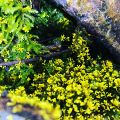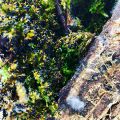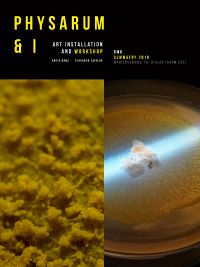| Line 107: | Line 107: | ||
*350 g sodium | *350 g sodium | ||
Heated up everything till it boiled and then we "painted" the maze with the salt solution on the normal agar plate. We placed | Heated up everything till it boiled and then we "painted" the maze with the salt solution on the normal agar plate. We placed the oat flakes at the start of the maze and at the finish and set up a time lapse to see what happened. We took a picture every 8 minutes and checked after 5 days. As it has been quite hot after 3 days the plate dried out and Physarum as well. The salt speeded up the process. See the result in the video below. | ||
{{#ev:youtube|hC-SauWZSxo}} | {{#ev:youtube|hC-SauWZSxo}} | ||
Revision as of 08:50, 3 July 2019
Farewell PP
My relationship with PP
Last semester I started working with the the single cell organism Physarum Polycephalum. I spent a lot of time figuring out how it grows the best. How to feed it. How to "store" it. Right after Christmas or during Christmas 2018 I was at a point where I finally felt comfortable with the organism. The days got longer again and the temperature slowly changed to milder temperatures. Polycephalum started getting even more comfortable and grew and grew. From now on I spent more and more time with changing petri dishes, taking pictures, feeding.
After some time it became that strong and fast that I could see it move with my naked eye and I needed to change the dishes every few hours as it started to climb out of it in to my closet and spread all over my Blurays and such.
Exhibition
In April 2019 I was part of "republic of spirits". An one night only exhibition project for the founding day of the Bauhaus 100 years ago. My setup was experimental and hands on. I wanted to share my passion and knowledge with all the people passing by. So I created a lab like environment with basic stuff you would find normally in a community lab. Easy for everyone to use. I took Polycephalum, Euglena and Pyrocystis fusiformis with me and let people discover it, ask questions and take PP home.
Project
In over half a year I kind of started having a serious relationship with Polycephalum. When I received my first sample of PP it was weak (because of winter times and my leck of experience) and I killed it several times. I was frustrated and fascinated at the same time. Sometimes I hated it because it grew all over the place and I had to clean everything. But from the very beginning I knew that it was living and that I have some sort of a responsibility towards it. Because of this whole relationship it is time to say goodbye to PP as the Petri dish is not its natural habitat. I am trying to get PP out of the intensive care of the nursery or shelter I gave him and go back to where it belongs too. And as in the area of Weimar PP is never seen before he might feel comfortable in the Ilm Park or the woods around town. Let's see.
First step
I started first to put him with the Petri dish into a box of cardboard and watered it from time to time.
It worked out pretty well and it started to grow into the box and even out of it.
2nd step
As this is still not so close to it's natural habitat I went to the forest to get a few natural materials for a nature box for PP. I collected dead wood, moss, grass, leaves, soil and of course not intended insects, bugs.
After a few days Polycephalum went through the whole live cycle and in the end built sporangia. I left it in the box to see if it at some point comes back to life. So far it doesn't. I also consider to set it free in the parc.
Soil
I collected some fresh soil in the parc and put it in a jar and Polycephalum on top.
Summaery 2019
Physarum & I
A project from Antje Danz & Fernanda Caicedo
The Goal of our work is to make people curious about nature and the meanings of intelligence and creativity in a playful way. We strongly believe in the importance of didactic learning. We want to give people the possibility to experience in a close and fun relationship Bioart and the interaction with organisms. They will be able to recognize and appreciate the capabilities of micro organisms, in our case represented by the Slime Mould "Physarum Polycephalum" and change their points of view about nature and life itself by exploring the collaborations between organisms of different species (Human/Protist).
Workshop
Visitors of the installation are invited to collaborate with the single celled social organism Physarum Polycephalum. In a small workshop set up they learn how to cultivate it, how to feed it, how to get creatively in contact and interaction with it and what they can learn from it.
Part of the single celled organism is shared with the audience as well as some easy to use Experimental Kits to collect information about the new habitat of the organism outside of the lab and its interaction especially with kids and people from a non scientific or artistic context as well as any other interested.
In the end Physarum it is fused back together into one big organism to see how it shares the outside of the lab experience among the parts.
Visitors will obtain instructions on how to document the interaction with their cell phone by using Applications such as FrameLapse or by using their camera software. They will also have the task of uploading their videos or screenshots on social networks using hashtags such as:
.#PhysarumAndMe #PhysarumIsAWriter #SummaeryBiolabExperiment
Maze Experiment - First try
We thought of how to do the experiment as easy as possible. First we prepared a normal agar plate with a 2 % agar solution and then In then an agar salt solution:
- 100 ml water
- 1 g agar
- 350 g sodium
Heated up everything till it boiled and then we "painted" the maze with the salt solution on the normal agar plate. We placed the oat flakes at the start of the maze and at the finish and set up a time lapse to see what happened. We took a picture every 8 minutes and checked after 5 days. As it has been quite hot after 3 days the plate dried out and Physarum as well. The salt speeded up the process. See the result in the video below.
Maze Experiment - second try
We want to improve the maze experiment so we started a second try. Normal agar plate was prepared again and also one full plate with the agar salt recipe. This time we printed a maze and cut out a stencil with coloured card board and put it in the liquid agar salt solution and let it sit till it cooled. We cut the maze out again and placed it in the petri dish with the 2 % water agar. We also painted a bit of the salty agar in areas we we don't want the organism to go. We placed oats at the end of the maze and the organism at the start. Time lapse is set.



































